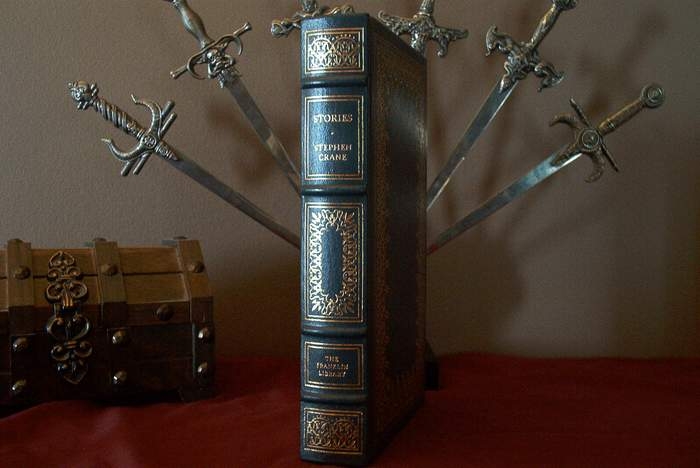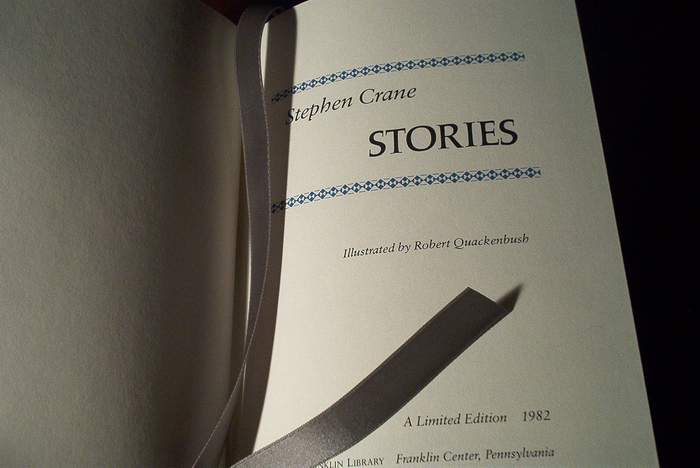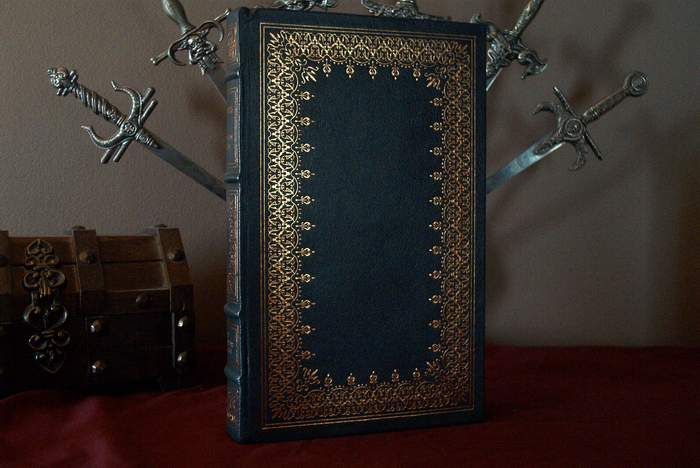Easton Press Stephen Crane books
The Red Badge of Courage - 100 Greatest Books Ever Written - 1980Maggie: A Girl of The Streets - 1981
Short Stories of Stephen Crane - 1996
Franklin Library Stephen Crane books
The Red Badge of Courage - 100 Greatest Masterpieces of American Literature - 1976The Red Badge of Courage - 100 Greatest Books of All Time - 1979
Stories of Stephen Crane - 100 Greatest Masterpieces of American Literature - 1982
Maggie: A Girl of The Streets - Collected Stories of the World's Greatest Writers - 1983
The Red Badge of Courage - World's Best Loved Books - 1983
Stephen Crane biography
Stephen Crane was an American novelist, short story writer, poet, and journalist, born on November 1, 1871, in Newark, New Jersey. He is best known for his realistic and often stark portrayal of war, particularly through his novel The Red Badge of Courage. Crane's life was marked by his brief but impactful literary career, as well as his adventurous spirit and unconventional lifestyle. Born into a Methodist family, Stephen Crane was the youngest of 14 children. His father, Reverend Jonathan Townley Crane, died when Stephen was just eight years old. Despite financial difficulties, Crane's mother, Mary Helen Crane, worked hard to support her family and encouraged her son's intellectual pursuits. Stephen Crane attended Syracuse University but left before completing his degree due to financial constraints. He began his career as a freelance writer and journalist in New York City, contributing to various newspapers and magazines. His experiences as a journalist, including covering the Spanish-American War in Cuba, greatly influenced his later works.
In 1893, Crane published his first novel, Maggie: A Girl of the Streets, a grim portrayal of urban poverty and the struggles of a young girl in New York City. The novel's stark realism and depiction of social issues set the tone for Crane's subsequent works. Crane's most famous work, The Red Badge of Courage, was published in 1895. The novel is a groundbreaking exploration of the psychological impact of war on a young soldier named Henry Fleming during the American Civil War. Crane's innovative use of psychological realism and his rejection of romanticized notions of warfare distinguished The Red Badge of Courage as a significant work in American literature.
Stephen Crane's writing style, characterized by its vivid imagery and impressionistic techniques, positioned him as a prominent figure in American literary naturalism. His later works, including The Open Boat and The Blue Hotel, continued to explore themes of human nature, fate, and survival.
The Open Boat
The Open Boat is a compelling short story that draws on the author's own experience. It was first published in 1897 and is based on Crane's harrowing ordeal as a correspondent covering the sinking of the USS Commodore during the Spanish-American War. The story is considered a masterpiece of naturalism, a literary movement that focused on portraying the influence of environment and heredity on human behavior. The Open Boat is set in a lifeboat at sea, where four survivors—an oiler, a correspondent (representing Crane himself), a cook, and the captain—find themselves after their ship sinks. The story chronicles their struggle for survival against the relentless forces of nature, emphasizing the indifference of the sea to their plight. Crane skillfully captures the psychological and physical toll of the men's predicament. The open boat becomes a microcosm of the human condition, illustrating the arbitrary and indifferent nature of the universe. The men face not only the physical challenges of the open sea but also the existential questions that arise when confronted with the vast and indifferent forces of nature. Crane employs vivid and detailed imagery to convey the harsh conditions faced by the men, from the relentless waves to the biting cold. The story explores themes of existentialism, fate, and the human response to adversity. Throughout the narrative, the characters grapple with their own mortality and the randomness of their situation.
One of the key elements of The Open Boat is the theme of cosmic irony, where the universe seems indifferent or even hostile to human aspirations and efforts. Despite their struggle and cooperation, the men in the lifeboat are at the mercy of unpredictable forces. Crane's portrayal of the human spirit in the face of adversity, as well as his exploration of the cosmic indifference of nature, has made The Open Boat a classic in American literature. The story remains relevant for its universal themes and its masterful depiction of the complexities of the human condition.
Stephen Crane poems
Stephen Crane, primarily known for his fiction, also wrote poetry that reflected his unique style and perspective. His poetry often shares themes with his prose, exploring human nature, existential questions, and the harsh realities of life. Following are a few notable Stephen Crane poems.
"I stood upon a high place" This poem reflects Crane's contemplation of life and death, exploring themes of mortality and the transient nature of human existence.
"A Man Said to the Universe" In this poem, Crane addresses existential questions, as a man confronts the indifferent and seemingly apathetic universe, questioning the meaning of life.
"In the Desert" Though not explicitly a desert setting, this poem reflects on the vastness and solitude of an open landscape, evoking a sense of desolation and emptiness.
"War Is Kind" A collection of poems under this title explores the ironies and tragedies of war. Crane's war poetry is known for its stark realism and anti-romantic portrayal of battle.
"Do not weep, maiden, for war is kind" This poem is part of the War Is Kind collection, presenting the contrasting emotions of war, challenging traditional notions of glory and heroism.
"A little ink more or less!" This poem reflects on the power of words and the role of the poet, suggesting that even a small amount of ink can have a profound impact.
While Stephen Crane's poetry may not be as widely studied as his prose, it offers insights into his worldview and complements his exploration of similar themes in his fiction.
Tragically, Stephen Crane's life was cut short when he died of tuberculosis on June 5, 1900, at the age of 28. Despite his relatively brief literary career, Crane left an indelible mark on American literature, influencing later generations of writers with his realistic portrayals of human experience, war, and the complexities of the human psyche.
Stephen Crane may be considered a forerunner, if not a founder of naturalism in American literature. However, the starkness of his realistic portrayals is relieved by his poetic charm and sympathetic understanding of character. Stephen Crane was also an innovator in verse techniques. His two volumes of poetry, The Black Riders and Other Lines (1895) and War is Kind and Other Poems (1899), are important early examples of experimental free-verse.
The Red Badge of Courage
The Red Badge of Courage, written in 1895 by Stephen Crane (1871-1900), is considered by many literary critics to be one of the greatest of all American novels. This is a book about the Civil War, and one Union soldier's struggle with his inner demons as he prepares for, and fights his first battle.
Henry Fleming has joined the Union army because of his romantic ideas of military life, but soon finds himself in the middle of a battle against a regiment of Confederate soldiers. Terrified, Henry deserts his comrades. Upon returning to his regiment, he struggles with his shame as he tries to redeem himself and prove his courage.
The Red Badge of Courage is one of the greatest war novels of all time. It reports on the American Civil War through the eyes of Henry Fleming, an ordinary farm boy turned soldier. It evokes the chaos and the dull clatter of war: the acrid smoke, the incessant rumours of coming battles, the filth and cold, the numbing monotony, the unworldly wailing of the dying.
Like an impressionist painter, Crane also captures the strange beauty of war: the brilliant red flags against a blue sky, steel bayonets flashing in the morning sun as soldiers step off into battle. In the midst of this chaotic outer world, he creates an intricate inner world as he takes us inside the head of Henry Fleming.
The Red Badge of Courage is Stephen Crane’s second book, notable for its realism and the fact that Crane had never personally experienced battle. Crane drew heavy inspiration from Century Magazine, a periodical known for its articles about the American Civil War. However, he criticized the articles for their lack of emotional depth and decided to write a war novel of his own. The manuscript was first serialized in December 1894 by The Philadelphia Press and quickly won Crane international acclaim before he died in June 1900 at the age of 28.
Maggie - A Girl of The Streets
In 1892 Stephen Crane (1871-1900) published Maggie, Girl of the Streets at his own expense. Considered at the time to be immature, it was a failure. Since that time it has come to be considered one of the earliest American realistic novels. Maggie is the story of a pretty child of the Bowery which is written with the same intensity and vivid scenes of his masterpiece The Red Badge of Courage. In her short life, Maggie "blossomed in a mud puddle", was driven to prostitution, and died by her own hand while still a teenager.
Not yet famous for his Civil War masterpiece, The Red Badge of Courage, Stephen Crane was unable to find a publisher for his brilliant Maggie: A Girl of the Streets, finally printing it himself in 1893.
Condemned and misunderstood during Crane’s lifetime, this starkly realistic story of a pretty child of the Bowery has since been recognized as a landmark work in American fiction.
Now Crane’s great short novel of life in turn-of-the-century New York is published in its original form, along with four of Crane’s best short stories The Blue Hotel, The Bride Comes to Yellow Sky, The Monster, and The Open Boat–stories of such remarkable power and clarity that they stand among the finest short stories ever written by an American.
Crane, who worked as a free lance reporter, was in many ways addicted to the low life of the cities.



Comments
Post a Comment
Share your best book review and recommendation